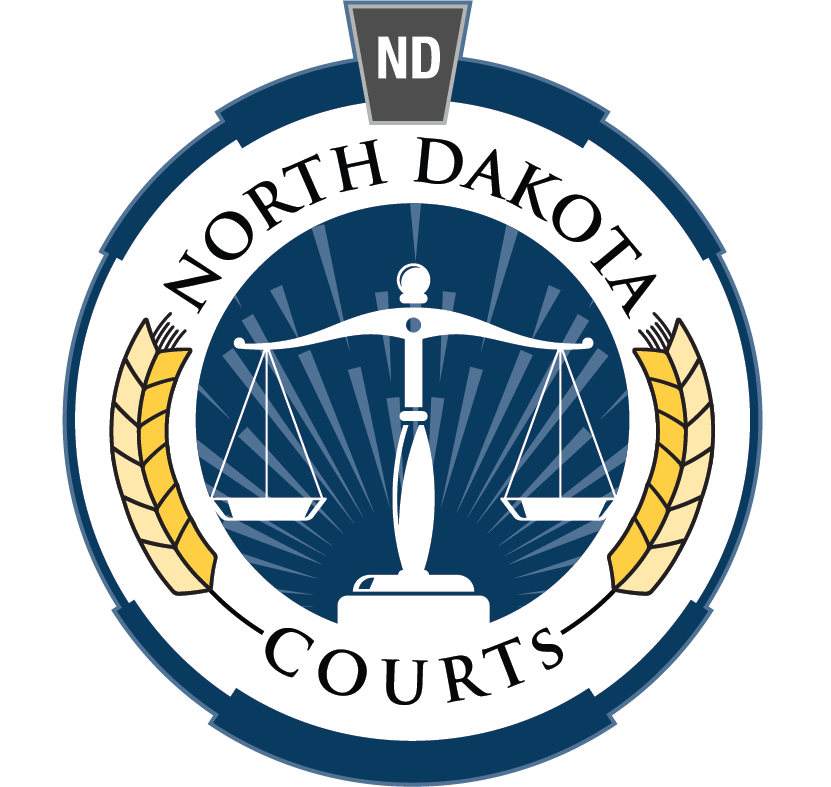Administrative Rule 58 - VEXATIOUS LITIGATION
Effective Date: 4/3/2025
Section 1. Purpose.
This rule addresses vexatious litigation, which impedes the proper functioning of the courts and court-related adjudicative bodies, while protecting reasonable access to those tribunals.
Section 2. Definitions.
(a) “Litigation” means any civil or disciplinary action or proceeding, including small claims actions, any appeal from an administrative agency, any review of a referee order by the district court, and any appeal to the supreme court. “Litigation” does not include criminal actions.
(b) For purposes of this rule, “presiding judge” means the presiding judge of a district under N.D. Sup. Ct. Admin. R. 2, the chair of the disciplinary board, or the chair of the judicial conduct commission. For purposes of this rule, and as context may require, references to a judge or to the court also refer to the disciplinary board or the judicial conduct commission. When the presiding judge has recused or is disqualified from a matter, the matter must be reassigned under N.D. Sup. Ct. Admin. R. 2(9) or (10).
(c) “Vexatious conduct” means conduct that:
(1) serves primarily to harass or maliciously injure another party in litigation;
(2) is not warranted under existing law and cannot be supported by a good faith argument for an extension, modification, or reversal of existing law;
(3) is imposed solely for delay;
(4) hinders the effective administration of justice;
(5) imposes an unacceptable burden on judicial personnel and resources; or
(6) impedes the normal and essential functioning of the judicial process.
(d) “Vexatious litigant” means a litigant, either self-represented or through an attorney, who:
(1) In the immediately preceding seven-year period, has commenced, prosecuted, or maintained at least two litigations that:
(A) involved vexatious conduct on the part of the litigant and
(B) were finally determined adversely to that person;
(2) After a litigation has been finally determined against the person, the person has repeatedly relitigated or attempted to relitigate either:
(A) the validity of the determination against the same party or parties as to whom the litigation was finally determined; or
(B) the cause of action, claim, controversy, or any of the issues of fact or law, determined or concluded by the final determination against the same party or parties as to whom the litigation was finally determined;
(3) In any litigation, the person repeatedly:
(A) files unmeritorious motions, pleadings, or other papers,;
(B) conducts unnecessary discovery,; or
(C) engages in any other tactics, and such conduct is frivolous or intended to cause unnecessary burden, expense, or delay; or
(4) In any litigation, the person has previously been declared a vexatious litigant by any state or federal court of record in any action or proceeding.
Section 3. Procedure-Designate Vexatious Litigant.
(a) At the request of a party or on the court’s own motion, the presiding judge may designate a litigant as a vexatious litigant.
(b) If the presiding judge finds by a preponderance of the evidence that there is a basis to conclude that a person is a vexatious litigant and that a pre-filing order should be issued, the presiding judge must issue a proposed pre-filing order along with the proposed findings supporting the issuance of the pre-filing order. The person who would be designated as a vexatious litigant in the proposed order will have 14 days to file a written response to the proposed order and findings. If a response is filed, the presiding judge may, in the judge’s discretion, grant a hearing on the proposed order. If no response is filed within 14 days, or if the presiding judge concludes following a response and any subsequent hearing that there is a basis for issuing the order, the presiding judge may issue the pre-filing order.
(c) The pre-filing order may:
(1) prohibit the vexatious litigant from filing any new litigation or any new documents in existing litigation in this state without first obtaining leave of a judge of the court where the litigation is proposed to be filed.
(2) require the vexatious litigant to furnish security to assure payment of the moving party’s reasonable expenses, costs, and, if authorized, attorney fees incurred in a pending action.
(3) require the vexatious litigant to take any other action reasonably necessary to curb the vexatious litigant’s vexatious conduct.
(d) A pre-filing order must contain:
(1) an exception allowing the person subject to the order to file an application seeking leave to file.
(2) a requirement that before ruling on the merits of any subsequent filing the court must rule on the application for leave to file.
(3) an award of all costs of the vexatious litigation against the filing party.
(4) an award of all reasonable attorneys’ fees and costs associated with responding to the vexatious litigant, including the cost of seeking the prefiling order.
Section 4. Procedure-New Litigation and Subsequent Filings.
(a) In order to file new litigation or documents into existing litigation, a vexatious litigant must file an application for leave to file using the form approved by the state court administrator. The documents the vexatious litigant seeks to file must be submitted separately from the application for leave to file. The documents the vexatious litigant seeks to file will not be docketed unless the court grants the application for leave to file.
(b) A court may permit the filing of new litigation or documents into existing litigation only if it appears that the litigation or document has merit and has not been filed for the purpose of harassment or delay.
(c) If the court issues an order granting leave to file new litigation or a document into existing litigation, a party’s time to answer or respond will begin to run when the party is served with the order of the court and a copy of the new litigation or document.
(d) The clerk may not file any litigation presented by a vexatious litigant subject to a pre-filing order unless the vexatious litigant first obtains an order permitting the filing. If the clerk mistakenly files the litigation without the order, any party may file a notice stating that the plaintiff or complaining party in a disciplinary proceeding is a vexatious litigant subject to a pre-filing order. The filing of such notice automatically stays the litigation. The litigation must be dismissed or denied unless the plaintiff or complainant, within 10 days of the filing of the notice, obtains an order permitting the litigation to proceed. If a party is served with new litigation but the action is not filed with the clerk, the party served is not required to respond to the new litigation unless the vexatious litigant obtains an order allowing the litigation to be filed and files and serves the new litigation.
(e) Upon receiving an application for leave to file, or upon notice from any party named in the litigation, the court must rule on the application before ruling on the merits of any proposed filing.
(f) An order granting leave to file is not required for an application for indigent defense services.
Section 5. Sanctions.
(a) Disobedience of a pre-filing order entered under this rule may be punished as a contempt of court.
(b) If a vexatious litigant subject to a pre-filing order files any new litigation without first obtaining the required leave of court, the court may summarily dismiss the action without notice.
(c) The court may award reasonable attorney’s fees and costs to the party filing the notice under section 4(d) of this rule.
Section 6. Appeal.
(a) A pre-filing order entered by a presiding judge designating a person as a vexatious litigant may be appealed to the supreme court under N.D.C.C. § 28-27-02 and N.D.R.App.P. 4.
(b) A pre-filing order entered by the supreme court is not appealable.
(c) An order denying the application for leave to file by a vexatious litigant is not appealable.
Section 7. Supreme Court Order.
The supreme court may, on the court’s own motion or the motion of any party to an appeal, enter a pre-filing order prohibiting a vexatious litigant from filing any new litigation in the courts of this state as a self-represented party without first obtaining leave of a judge of the court where the litigation is proposed to be filed. If the supreme court finds that there is a basis to conclude that a person is a vexatious litigant and that a pre-filing order should be issued, the court must issue a proposed pre-filing order along with the proposed findings supporting the issuance of the pre-filing order. The person who would be designated as a vexatious litigant in the proposed order will have 14 days to file a written response to the proposed order and findings. If a response is filed, the supreme court may, in the court’s discretion, grant a hearing on the proposed order. If no response is filed within 14 days, or if the supreme court concludes following a response and any subsequent hearing that there is a basis for issuing the order, the supreme court may issue the pre-filing order.
Section 8. Electronic Filing.
Self-represented parties who have been declared vexatious litigants will not be permitted to file documents electronically and will not be provided a user ID and password to access the system. A self-represented vexatious litigant must file in paper format in compliance with all other Rules of Court.
Section 9. Roster.
The clerk of court must provide a copy of any pre-filing order issued under this rule to the state court administrator and the United States District Court for the District of North Dakota. The state court administrator must maintain a list (current list) of vexatious litigants subject to pre-filing orders.
Prior Rosters:
- 2025-09-10 Roster of Vexatious Litigants
- 2025-07-30 Roster of Vexatious Litigants
- 2024-07-19 Roster of Vexatious Litigants
- 2023-05-05 Roster of Vexatious Litigants
- 2023-01-27 Roster of Vexatious Litigants
- 2022-11-07 Roster of Vexatious Litigants
- 2022-10-05 Roster of Vexatious Litigants
- 2022-07-14 Roster of Vexatious Litigants
- 2022-05-27 Rosterof Vexatious Litigants
Section 10. Effect of Pre-Filing Order.
A pre-filing order entered under this rule supersedes any other order limiting or enjoining a person’s ability to file or serve papers or pleadings in any North Dakota state court litigation.
Rule 58 was rewritten and adopted effective, March 1, 2025 and amended effective April 3, 2025. Previous rule was adopted effective March 1, 2017; amended effective June 21, 2017; August 11, 2021; September 1, 2022; January 25, 2023.
The rule was amended effective April 3, 2025 to correspond with legislation 182 enacted in the 2025 Legislative Session.
SOURCES: Joint Procedure Committee Minutes of April 26, 2024, pages 6-7; January 26, 2024, pages 13-14; April 29, 2022, pages 13-14; May 12-13, 2016, pages 25- 29. Idaho Ct. Admin. R. 59.
STATUTES AFFECTED:
CONSIDERED: N.D.C.C. §§ 27-05-06, 27-05-22, 27-05-23, 28-27-02.

